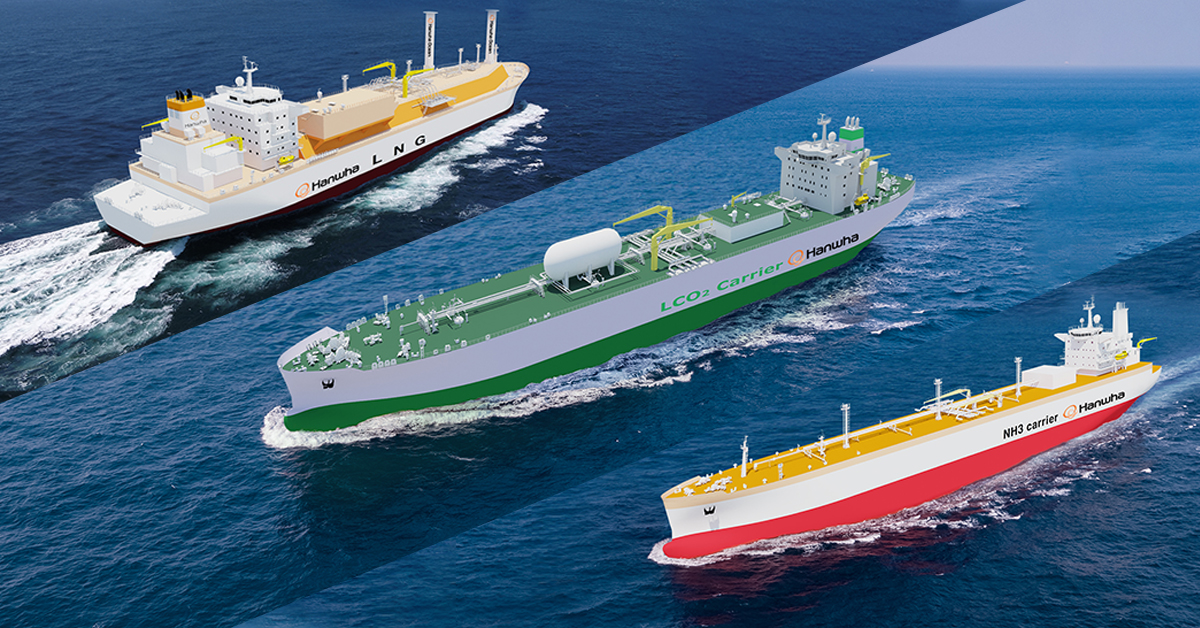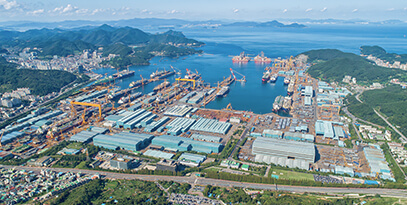Decarbonization of Shipping: An Ambitious Global
Test Bed for Green Ships Sets Sail
Dong Kwan (DK) Kim
Vice Chairman, Hanwha Group
*This article was originally published on January 17, 2024 as a contribution piece to the World Economic Forum (WEF) during the Annual Meeting 2024.
• Change is underway to decarbonize shipping, but the industry continues to face a wide range of challenges
• Green ship technology is central to advancing decarbonization efforts, but demand for advanced vessels is insufficient
• A newly-established shipping company powered by green ships will provide opportunities for innovation and collaboration

With 90% of traded goods being transported across the ocean, the shipping industry stands at the heart of the global economy. Although shipping is highly efficient in terms of CO2 emissions per cargo weight, the industry as a whole is a major contributor to the world’s carbon footprint, accounting for 3% of global greenhouse gas (GHG) emissions.
This is due to the sheer volume of movement and the industry’s heavy dependence on fossil fuels.
As pressure mounts to deliver measurable progress toward carbon neutrality, the International Maritime Organization (IMO) has revised its GHG emissions reduction strategy, pledging to reach net zero by or around 2050. In line with this progression, an increasing number of large companies have been placing alternative-fuel ship orders. Additionally, more stringent measures such as the EU Emissions Trading System (ETS) and FuelEU Maritime initiative are expected to lead to growing costs for heavy emitters.
At the same time, incentives like the US Inflation Reduction Act are generating opportunities to build and strengthen the value chain of clean energy sources, such as hydrogen, which will be crucial to powering carbon-free future vessels.
Why shipping is a hard-to-abate sector
Change is evidently underway, but it is not yet swift enough to meet net zero targets. A web of complexities including technical difficulties and costs associated with decarbonization mean the shipping industry remains a hard-to-abate sector. Here are some of the main obstacles.
1. A lack of viable alternative fuels: Although many types of alternative fuels and powering mechanisms are being explored such as hydrogen, ammonia, methanol, biofuels, fuel cells, and more, there is no one clear frontrunner in the race.
2. Demand for green ships is lackluster: Building a new ship is a massive endeavor, requiring immense capital investment. Yet, these assets take roughly two to three years to build and last for two to three decades. Without clarity on how new ships will be fueled, shipowners are hesitant to place orders for new advanced vessels.
3. Asset and infrastructure development is slow: With inadequate demand, shipbuilders and infrastructure developers are unable to advance new technologies and build infrastructure that can accommodate future-ready vessels.
4. Uncertainties in regulations: Although carbon emission regulations are advancing in regions such as the European Union (EU), they are loosely defined with many uncertainties around accountability. The global nature of shipping necessitates a currently lacking unified industry effort to prevent emissions from merely shifting from regions with tight regulations to those with less stringent measures.
5. Too many stakeholders: For any given shipment, the parties involved easily span from the owner of goods (shipper) to the shipowner, ship operator, freight forwarder, and, ultimately the customer. Who should be accountable for the carbon emitted? Questions like these have led to disputes between shipowners and traders, signaling the growing complexity behind regulatory enforcement and lack of clarity around roles and responsibilities.
How to bring about change in shipping
How can we bring about change in the face of such complexities? Breaking a gridlock of this nature requires a fundamentally different strategy — one that can create real change in one field and spark progress in others. In the shipping industry, we can achieve a breakthrough by adopting a three-step approach.
1. Identify the catalyst for change
At Hanwha, we believe green ship technology is a central piece of the puzzle. Without it, decarbonization cannot take place at the requisite speed and scale. The fact that 85% of emissions come from a specific category of vessels — deep sea ships — gives the problem of decarbonization greater focus, making innovation in this area promising. With a world-class shipbuilder, Hanwha Ocean, among our subsidiaries, we are dedicated to delivering disruptive yet economically feasible, technical solutions in this field.
2. Innovate, test, and repeat
To generate the necessary demand for the advancement of green ship technology, we have joined the World Economic Forum’s First Movers Coalition (FMC) and established a global shipping company, which will operate a new fleet of cutting-edge future-ready vessels. With entirely new assets, the fleet will serve as a strong test bed for carbon-neutral and carbon-free vessels, lowering the emissions burden for traders and providing shipowners with increased flexibility to meet the diverse fuel requirements of their customers.
The advanced vessels will initially include ships that run on liquefied natural gas (LNG) and methanol and advance over time to those that run on ammonia, and hydrogen, which do not emit carbon when burnt as a fuel source. We will also step up the development of ship digitalization, with the aim of powering vessels with fuel cells and electricity, mirroring the evolution from conventional cars to electric vehicles in the automobile industry.
3. Collaborate and build scale
Our membership with the FMC will pave the way for new partnerships and pilot programs that enable collaboration with multiple stakeholders, including policymakers, customers, research institutes, and port authorities. However, we can only build sustained momentum through mass adoption and commercialization of newly developed technology, requiring a concerted effort between the public and private sectors as well as parties across the entire energy value chain. This, coupled with clearly defined strong global regulations, will build an ecosystem for change, leading to the rapid scaling of green vessels to usher in a new era of global shipping.
Big problems require bold solutions. The barriers to decarbonizing shipping are manifold, but a singular driving force can have a ripple effect, opening up new opportunities for many different parties. Working together to uncover these novel growth drivers is what ultimately will help us turn the tide on emissions in the shipping industry.






